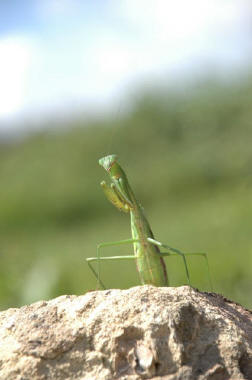(10/3) This year, I put my tomato patch to bed for the winter earlier than usual. Given the more abundant rainfall this summer and the fact that I had spaced my tomatoes too closely, fungal diseases had taken their toll. I decided that rather than clearing my tomato patch after I cleared the Thanksgiving table, I would remove tomato debris from the garden thoroughly
and earlier than usual. I had the best of intentions.
As I was pulling plant debris and tomato stakes, a praying mantid appeared, seemingly from nowhere. Her brown and green coloring had camouflaged her. She scrambled across the cleared soil and nimbly leapt on top of a nearby rock. There, she positioned herself so she stood erect on her four back legs. Her two front legs, armed with barbs for stabbing and holding prey,
were in front of her chest, assuming the position that lends itself to the nickname of "praying" mantid. Her gargantuan eyeballs surveyed the scene, her head able to turn an impressive 180 degrees. I quickly realized that what I call "cleaning up" meant complete devastation of her habitat. In addition, I had just interrupted an important part of the life cycle of this
praying mantid, an insect that I rely upon to control unwanted pests in my garden.
 Praying mantids are generalist predators. Not only do they consume pests in the garden, they will eat beneficial insects too. They even practice two forms of cannibalism- one for the young and one for those of reproductive maturity. In the spring, once the eggs hatch, the young will eat each other if other food
sources are not readily available. Then, at the end of the summer, once females have reached reproductive maturity, another form of cannibalism takes place. While mating, the mounted female will turn around and bite the head off the distracted male, consuming the rest of his body later. Since the praying mantid that I found had a head, I presume it was a female.
Praying mantids are generalist predators. Not only do they consume pests in the garden, they will eat beneficial insects too. They even practice two forms of cannibalism- one for the young and one for those of reproductive maturity. In the spring, once the eggs hatch, the young will eat each other if other food
sources are not readily available. Then, at the end of the summer, once females have reached reproductive maturity, another form of cannibalism takes place. While mating, the mounted female will turn around and bite the head off the distracted male, consuming the rest of his body later. Since the praying mantid that I found had a head, I presume it was a female.
Realizing that this mantid was most likely a female led me to understand that she probably hadnít laid her eggs yet. If I didnít relocate her to a safer place in the garden, Iíd have less praying mantids in the garden next year. The females make a foamy, tan colored egg sac called an ootheca. It is filled with up to two hundred eggs. I decided to finish clearing the
tomatoes and then move her to the patch of wildflowers, where I would leave the stalks in place for oothecas and the flower heads would serve as food for the birds in the winter. Sadly, my plan was not realized.
Iíd been lost in thought as I worked when I turned around to see that she was charging me. Praying mantids move fast, which is one of the many reasons that they are successful hunters. Confused, I took a few steps to the right, and she pivoted and continued her charge. I took a few steps to the left and the same thing happened. Since only mammals have feelings, I know
that she wasnít mad at me, but she certainly seemed determinedÖ.to do what, I do not know. I moved to the right again and, sadly, dislodged a rock that careened in her direction. Iíll leave it at that.
It was disheartening. I had the best of intentions to clean up my garden and to relocate this praying mantid after I had disturbed her habitat. Instead, I eliminated her. I hope that, unlike me, you will pause to look for the presence of praying mantids and other beneficial insects before you start to "clean up". I wish that I had taken the time to look before I
started clearing. I also wish that I had moved the praying mantid to a safer location as soon as I found her. I tell you this as a cautionary tale in the hopes that as you sit around the Thanksgiving table talking about your gardening successes and failures, you wonít have a story that ended like mine.